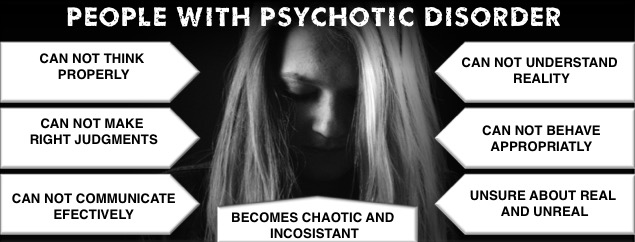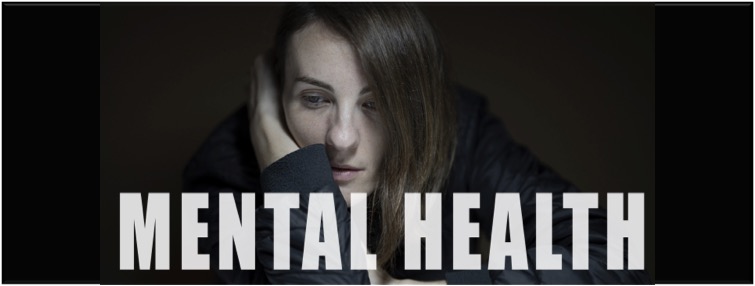What is Psychotic disorder
Psychotic disorders also called psychoses. Psychotic disorders are some serious mental health issues that affect the way your mind functions. These disorders can affect adversely on your way of thinking, judgments, responding and communication. It causes inability to understand reality and you start behaving inappropriately. It is really important to for you to understand main types and symptoms of psychotic disorder and treatment options for them.
Different types of psychotic disorders are becomes severe mental issues because they cause abnormality in the way of thinking and perceptions. Psychotic disorders are mental disorders during which personality of a person is severely confused. People with psychotic issues don’t understand the reality. At the time of psychotic episodes they get confused about what is real and what is not real.
It is also important to know that psychosis is not always present in all mental health conditions, and the symptoms considerably vary by individual.
People experiences hallucinations, delusions and off-the-wall behaviour. Their speech becomes completely chaotic and inconsistent.

Symptoms of psychotic disorder
The major symptoms of psychotic disorder are hallucinations, delusions, and disordered thoughts.
Hallucinations:
A situation when a person starts seeing things which are fictional, , hearing imaginary voices or sounds, smelling unreal odours, tasting funny or experiencing things that does not exist is called hallucination. They might feel sensations on skin even when nothing is close to their body.
Delusions:
A situation when a person makes a false but strong belief about some thing and don’t agree with the fact even after proving it by any means. For example, if a person believes that some one wants to kill him by poisoning his food, he will not believe that the food is fine even if you prove and show that the food is fine.

Other possible symptoms of psychotic disorder include:
• Disorganised and inconsistent or unclear speech
• Difficulty in performing tasks, poor attention span, unclear speech and difficulty in following a conversation. Confusion.
• Some times they behave strange and become dangerous.
• Their physical movements are slowed down and abnormal.
• They do not take care of personal hygiene.
• They can not manage daily activities or routine.
• They create unintentional problems at home and work.
They create problems in relationships
• They become unexpressive, detached and cold.
• Some times they have symptoms of depression or mania
The symptoms for a psychotic disorder of a person can change with the time. Its not sure that someone will have same symptom for the same psychotic disorder overtime.
People with manic depression may also have psychotic symptoms. Other problems which will cause psychosis include alcohol and some drugs, brain tumours, brain infections, and stroke.
Types of Psychotic disorder
There are many different types of psychotic disorder. Psychosis is Actually related to multiple types of mental health conditions.
Schizophrenia
Schizophrenia is the most common type of psychotic disorder. Patients with this condition experience changes in behaviour, because schizophrenia can cause delusions and hallucinations.
These symptoms last longer than six months. Most of the people who are diagnosed with this type of disorder show a decline in social function, school and work because it affects a person’s thinking, perceptions, and sense of self.
The exact cause of this complex disorder is unknown, people having relatives with schizophrenia are more likely to have a higher risk for developing it.
Studies has shown that heredity or genetics are major contributing factor for the development of schizophrenia.
Schizoaffective disorder
Schizoaffective disorder is marked by a combination of schizophrenia symptoms, such as hallucinations or delusions, and mood disorder symptoms, such as depression or mania.
People with schizoaffective experience both psychosis (schizophrenia) and a mood disorder (depression).
Untreated schizoaffective disorder can lead to problems in functioning at work, at school and in social situations. It can cause loneliness and trouble holding down a job or attending school.
People with schizoaffective disorder may need assistance and support with daily functioning. Treatment can help in managing symptoms of these types of psychotic disorder and improving quality of life.
Development and course of schizoaffective disorder can vary. The defining symptoms include a major mood episode and period of psychotic symptoms at least a two-weeks, when a major mood episode is not present.
Schizophreniform disorder
Schizophreniform is a psychotic illness with similar symptoms like schizophrenia, but Schizophreniform disorder is a short-term type of psychotic disorder, where the symptoms last for less than 6 months. It is also a serious mental condition that can distort the way of your thinking, your actions, expression of emotions, perception of reality and relating others.
This causes problems with your relationships, employment and other aspects of your routine normal life. Some schizophreniform disorder patients get in to substance abuse. This is a wrong decision and can worsen quality of life even more. Substance abuse make it harder to recover from schizophreniform disorder.
Brief psychotic disorder
It is differentiated from schizophreniform disorder and schizophrenia by the duration of person’s psychotic illness.
People with brief psychotic disorder have a sudden and short period of psychotic behaviour triggered by extreme stress such as a death in the family or traumatic accident.
The affected person may or may not be aware of his symptoms and strange behaviour but psychotic behaviour lasts less than 1 month and usually after that people recover completely and come back to their normal routine life.
Other than family history of psychotic disorder such as depression or bipolar disorder, studies suggests that poor coping skills can trigger this disorder to defend or escape from a very frightening or stressful situation.

Delusional disorder
The main symptoms of this psychotic disorder is the presence of one or more delusions. People who have it cannot tell what’s real from what is imagined.
A delusion is a strong and unshakable belief in something that is untrue. That belief is not a part of his or her culture and almost everyone else knows that, this belief is false.
Delusional disorder is very different from schizophrenia. In Delusional disorder there are no any other psychotic symptoms other than delusions are present. These delusions are based on mistaken perceptions or experiences, which are not true at all in reality or highly exaggerated.
In some cases, life of people with delusional disorder are disrupted because they get so preoccupied with their delusions.
Shared psychotic disorder
As the name suggests, these types of psychotic disorder (shared psychotic disorder) happens when any one person in a relationship have a delusion and the partner adopts it too.
A shared psychotic disorder is an uncommon mental illness, in which a healthy person starts getting engaged with the delusions of someone else who has a psychotic disorder such as schizophrenia.
Shared psychotic disorders typically happen only in long term relationships. Especially if the person who has the psychotic disorder is dominating and the other one is passive.
These couples generally have a close emotional connection with each other. But, they usually don’t have good social bonding’s.
Shared types of psychotic disorders may also happen in groups of people. It happens when many people closely involved with the person who has a psychotic disorder (called “the madness of many”). For example, this can happen in a crowd if the leader is psychotic and his followers adopt his delusions.
Shared psychotic disorders may become a problem if they are not treated on time. People with a delusional disorder many a time don’t realize that they seriously need treatment and they choose not to take medications.
Some Other Types of Psychotic Disorder
Substance-induced psychotic disorder:
This condition is caused by the use of or withdrawal from drugs that cause a specific mental health condition where an individual experiences hallucinations, delusions, or confused speech.
Symptoms of substance-induced psychotic disorder can be seen almost immediately after consuming or ingesting certain substances. Symptoms of substance-induced psychotic disorder can also be seen during withdrawal.
People can experience psychotic episodes just when they are using, or just when they are not using drugs or alcohol. They may even develop SIPD when they are in recovery from a substance use disorder.
Substance-induced psychotic disorder is generally caused by misuse of drugs or alcohol. Some other risk factors like brain injury or stroke, family history of mood disorder, Alzheimer’s disease or genetic abnormalities may make people more prone to developing these types of psychotic disorder.
Psychotic disorder due to another medical condition:
Hallucinations and delusions or other symptoms can happen because of any other illness which affects function of brain, such as brain tumour or head injury.
It is important to understand temporal relationship between the medical and psychotic condition in case of Psychotic disorder due to another medical condition
Treatment of the medical condition may reduce the severity of psychotic symptoms. Some patients may also need a specific treatment for the psychotic symptoms.
Paraphrenia
This condition has symptoms very similar to schizophrenia. People who are suffering from paraphrenia are more likely to be diagnosed with some other disorders. Paraphrenia starts late in the life, when people are elderly.
People with these types of psychotic disorder (paraphrenia) can experience delusions, strange or unusual thoughts or abnormal behaviour. Unlike schizophrenia, personality of people is not usually fundamentally disturbed and they typically continue a normal affect.
Who Can Get a Psychotic Disorder?
About 1 percent of the population encounter a psychotic disorder in life. Most commonly, these conditions are found in those people who are in their late teens to early thirties. Psychotic disorder effects men and women equally.
Like other mental conditions, psychotic disorders are usually genetic. People with family history of this type of disorder are more likely to develop this mental condition than those who don’t have any family history of it.
These types of psychotic disorder are linked to hyper activity of certain chemicals in the brain which are essential for normal functioning. Additionally, people who have experienced brain injury during childhood are at a greater risk of developing the psychotic disorders.
Diagnosis of Psychotic Disorder
If symptoms of a psychotic disorder appear in a person, then the doctor gathers his medical history and also conduct a physical exam.
The person may have to get blood tests and brain imaging if required (such as MRI scans). These tests are done to rule out physical reasons for the condition.
Once the physical reasons for abnormal behaviours are ruled out and doctor finds no physical reason for the symptoms, they refer the person to a psychiatrist or psychologist.
These psychologist then use specially designed interview and specific assessment tools to find out what type of a psychotic disorder the person have.
Treatments for Psychotic disorder
Medication and psychotherapy are the two main types of treatment for various types of psychotic disorders. Based on severity of your conditions psychiatrist will decide which treatment is best for you.
Medications
The signature medications for the treatment of psychotic disorders are antipsychotics. These medicines help in blocking serotonin or dopamine receptors in the brain and prevent hallucinations and delusions.
Depending on individual, it may be necessary for doctor to suggest more than one medicine back to back, until the proper medication is found that gives the required results.
For treatment of mood disorder, your doctor can also suggest antidepressant medicine. These medicine help in improving symptoms related to depression, like sadness and hopelessness.
Psychotherapy
Psychotherapy for psychotic disorders can include :
- Individual sessions,
- Family sessions and
- Support groups.
Cognitive behavioural therapy (CBT)
Cognitive behavioural therapy help by changing individual’s thought patterns that may lead to delusions and hallucinations.
Individual talk therapy
It helps in working on your feelings, that may be useful in treating occurrence of trauma.
Psychoanalytic therapy
It may have a considreble impact on the functioning of people with psychosis disorder.
Social rehabilitation may help them who have isolated themselves because to their symptoms of psychotic disorder.
Halenesspro Opinion
Generally, most of the patients are treated as outpatients, but in critical cases, when the physical well-being is in danger, hospitalization might be the better option to stabilize patient’s condition.
Other than medication and psychotherapy, self-help may also aid in effectively managing life with psychotic disorders.
It is important for the patient to learn how to cope with these episodes. Studying types and symptoms of psychotic disorder and learning more about the specific disorder is essential for managing a healthy, happy, fulfilling life.






